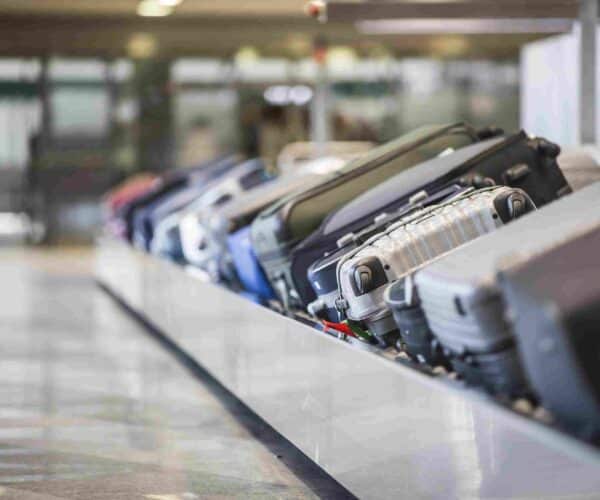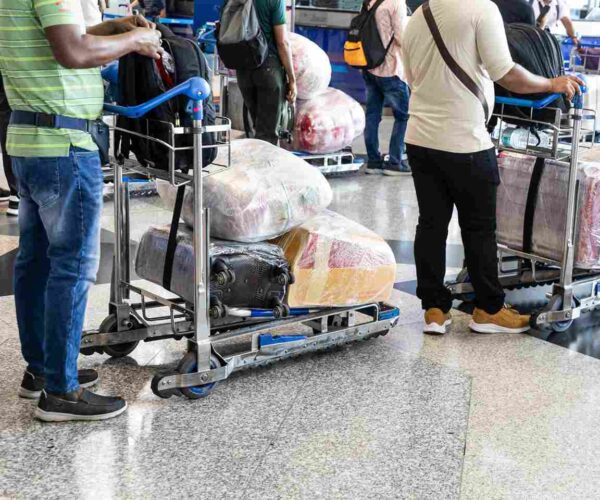When planning a golf trip abroad, your first thoughts are likely of warmer weather, stunning courses, and a well-earned round or two. But before you can tee off, there’s the challenge of getting your golf clubs there in one piece.
According to Sporting Insights, 51% of UK and Irish golfers travel overseas to play. While many resorts offer equipment hire, most golfers prefer to bring their own clubs for performance, familiarity, and overall enjoyment. However, flying with golf gear can be tricky, airlines have different rules, baggage fees can add up, and there’s always the risk of damage in transit.
Golf equipment is often classified differently depending on the airline—it might be called golf carriage, sports equipment, or outsized luggage. So, what are the airline policies? Do you need a specialist golf travel bag? Would it be easier to ship your clubs instead?
Navigating your way through airline guidelines can be a bit of a mind field so we’ve unpacked the important details you need to know. From booking your golf bags onto a flight, choosing the best golf travel bag to packing your clubs securely and avoiding unnecessary costs, we’ve covered what you need to know.
Flying with golf clubs - Airline rules explained

All airlines have slightly different rules when it comes to travelling with sports equipment. Some airlines allow you to check golf clubs as part of your standard baggage allowance while others charge extra due to their size and weight. What they have in common is that they need to be pre-booked onto a flight. Here’s a rundown of the main considerations.
Do you need a golf travel bag?
Some airlines require that sports equipment checked into the hold is packed in a secure, purpose-designed bag. While you could use a box, this isn’t always accepted and rules vary between airlines. For peace of mind, a proper golf travel bag is highly recommended. After all, you can’t always rely on baggage handlers to treat your clubs with the same care you would!
Airline baggage policies for golf clubs
Whilst the discrepancies between airlines can be confusing, the types of factors that judge your golf bags are similar. These are the key points to check when booking your golf clubs onto a flight.
Weight and size limits
Airlines typically allow checked baggage up to 23kg or 32kg. A fully loaded golf bag can weigh between 15-20kg, so check weight limits carefully to avoid excess baggage fees. Dimensions are also important and going over the specification could lead to fees if they become classed as oversized.
Packed golf baggage requirements
Mishandling by baggage handlers is a real concern, so investing in a protective golf travel bag will provide better protection whilst they’re in transit.
Sports equipment insurance
Check what your airline stipulates as to their liability with your sports equipment. Some airlines take less responsibility for damage to ‘oversized’ luggage and suggest you ensure you have sports equipment insurance within your travel policy.
All airlines also stipulate that sports equipment, however they book it, needs to be arranged prior to arrival at the airport to ensure there is space for it on the flight.
Compare airlines and golf bag charges
Here’s a quick comparison of how major airlines handle golf luggage:
Airline | Golf bag policy | Weight/Size | Luggage fee |
British Airways |
Counts as 1 item of checked baggage allowance. | Up to 23 kg | £65-£80 each way |
EasyJet | Add as sports equipment during the booking process.
| Small (up to 20kg)
| £35-£45 each way |
Jet2 | Add as sports equipment during the booking process. | Up to 22kg | £30 each way |
Ryanair |
Add as sports equipment during the booking process.
| Up to 20kg | £35-£45 each way |
TUI | Add sports equipment after the booking process but more than 72 hours before arriving at the airport.
| Up to 20kg | £27-£40 each way |
Wizz Air | Add sports equipment after the booking process but more than 72 hours before arriving at the airport.
| Up to 32kg Max dimensions
| £35-£45 each way |
What makes a good golf travel bag?

When travelling with golf clubs, investing in a high-quality travel bag is essential for protecting your equipment and ensuring a hassle-free trip. Here are the key features to look for when choosing the best golf travel bag:
Padding & Protection
One of the most important factors in a golf travel bag is adequate padding, particularly around the club heads. The head of a golf club is the most vulnerable part, and without proper cushioning, clubs can suffer dents, cracks, or complete breakage during transit. Some premium travel bags even include internal straps to keep clubs securely in place.
Durability
Frequent travellers should prioritise a golf travel bag made from durable materials such as heavy-duty nylon or reinforced polyester. Strong zips, reinforced stitching, and tough fabric help withstand the wear and tear of airport handling. Hard-shell cases offer maximum protection, but high-quality soft bags with reinforced padding can also be effective.
Wheels
A golf travel bag with built-in wheels significantly improves manoeuvrability, especially when navigating through busy airports. Two-wheel designs allow for easy pulling, while four-wheel options provide even greater stability and smooth movement. If you plan to travel frequently, a wheeled bag is highly recommended.
Size & Storage
Choosing a golf travel bag that is compact yet spacious enough to fit all your essentials is key. A well-designed bag will allow you to carry not only your clubs but also additional accessories like shoes, gloves, and tees without unnecessary bulk. Opting for a lightweight travel bag can help reduce baggage fees and make transportation easier.
Best types of golf bags for protecting your clubs

There are several types of golf travel bags, each catering to different needs. Choosing the right one depends on how often you travel, your budget, and your preference for protection versus portability.
Soft travel bags
Prices ranging from £30-£70
- Lightweight and flexible, making them easier to store when not in use.
- Typically, less expensive than hard cases.
- Offer moderate protection with padded interiors.
- Ideal for golfers who travel occasionally and prefer a more portable option.
Hard Case Travel Bags
- Prices ranging from £160-£300
- Provide maximum protection against airline mishandling.
- Constructed from rigid materials like moulded plastic or composite shells.
- More durable but can be bulkier and heavier.
- Best suited for frequent travellers who want the highest level of protection.
Golf Travel Bags with Wheels
Prices ranging from £60-£250
- Feature built-in wheels for easier transportation.
- Available in both soft and hard case designs.
- Well-padded for robust protection.
- A great choice for long-haul travel and those who frequently navigate airports.
Golf Travel Covers
Prices ranging from £30-£70
- Designed as a protective cover that fits over a standard golf bag.
- Lightweight and easy to store when not in use.
- Provide added protection against dirt, moisture, and minor impacts.
- Suitable for golfers who prefer using their everyday bag for travel.
How to pack your golf clubs for travel
Step-by-step packing guide
- Use a stiff arm or PVC pipe – This prevents club heads from snapping.
- Wrap clubs in towels or bubble wrap – Adds extra padding.
- Secure loose items – Place balls, gloves, and tees in zipped compartments.
- Lock the bag – A TSA-approved lock keeps your clubs safe.
Alternatives to taking golf clubs on a flight

If you’re fairly new to golf or looking to travel light, you may not fancy the idea of taking a golf bag with you – if you don’t want the hassle of checking your clubs, you can consider these options:
Shipping Your Clubs
Pros: Convenient, avoids baggage fees
Cons: Expensive (£50-£100+ per trip)
Driving with Your Clubs
Pros: No airline baggage fees
Cons: Only feasible for certain destinations
Hiring Clubs at Your Destination
Pros: No luggage hassle, try new clubs
Cons: Rental fees add up, clubs may not suit your game, not always access to rental options.
Top tips for hassle-free golf travel
- Book direct flights: Fewer connections mean less chance of lost luggage.
- Arrive early: Golf bags take longer to check in.
- Consider renting clubs: If baggage costs are too high, renting may be cheaper.
- Get golf travel insurance: Make sure your policy covers golf equipment in case of damage or loss.
Other FAQs for travelling with golf clubs
Can I bring a golf club as carry-on luggage?
No, due to safety regulations. All clubs must be checked in.
What if my golf clubs get lost or damaged?
- Report it immediately to the airline.
- Check your travel insurance to ensure you’re covered for lost/damaged golf equipment.
Travelling with golf clubs doesn’t have to be stressful, it’s all about preparation. Choosing the right golf travel bag, packing carefully, and knowing your airline’s baggage rules will make your trip smooth and hassle-free. If you travel often, investing in a good quality golf travel bag will protect your clubs and save you money in the long run.
Get Sports Equipment Insurance for Golf Clubs from SportsCover Direct
When heading abroad for a golf trip, having insurance is always a smart move—but if you’re travelling with valuable golf clubs, it’s even more necessary. Lost, damaged, or stolen clubs can leave you facing a significant replacement cost, not to mention the frustration of missing out on pre-booked rounds. Specialist golf travel insurance ensures you’re covered, protecting both your equipment and your trip from unexpected disruptions.
SportsCover Direct’s specialist golf travel insurance can make sure that you don’t lose out financially when the unforeseen happens travelling. That way, you can relax and make the most of your trip in the knowledge that any unfortunate circumstances won’t hit you in the pocket.
Find out more on our travel insurance for golfers today, including our flexible monthly payment plans and affordable pricing.
This blog has been created as general information and should not be taken as advice. Make sure you have the correct level of insurance for your requirements and always review policy documentation.